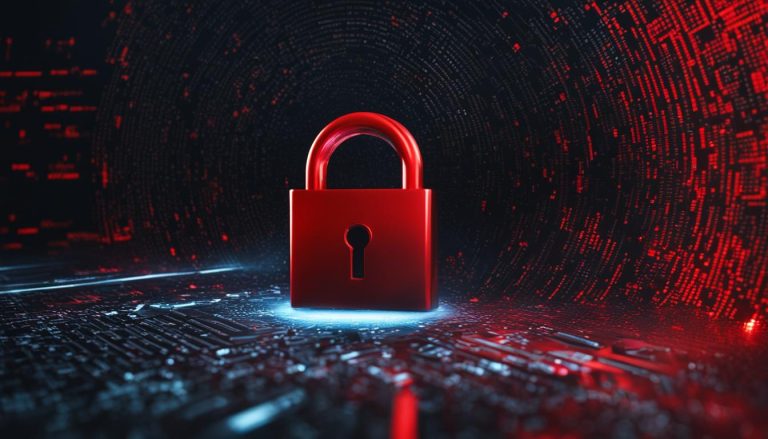Greetings! In this article, I will demystify the concept of RSA encryption and explain how it works. If you’ve ever wondered how data transmission and communication on the internet are secured, then you’re in the right place. Let’s dive into the world of RSA encryption and uncover its secrets together.
Key Takeaways:
- RSA encryption is a widely used public-key encryption algorithm.
- It is named after its creators Rivest, Shamir, and Adleman.
- It is based on prime numbers and secures data transmission on the internet.
- RSA encryption involves using a public key for encryption and a private key for decryption.
- It is utilized in various applications, including email, file sharing, and secure internet communications.
How does RSA Encryption work?
RSA encryption is a powerful cryptographic algorithm that ensures secure data transmission and communication. It utilizes a combination of two keys – a public key and a private key – to encrypt and decrypt messages. The process of RSA encryption involves several steps:
- Key Generation: Two large prime numbers are chosen and used to generate the public and private keys.
- Message Encryption: The sender represents the message as an integer and uses the recipient’s public key to calculate the ciphertext.
- Ciphertext Transmission: The ciphertext is sent to the receiver via a secure channel.
- Message Decryption: The receiver uses their private key to decrypt the ciphertext and convert it back into the original message.
Here’s an example to illustrate the process of RSA encryption:
| Step | Description |
|---|---|
| 1 | Key Generation |
| 2 | Message Encryption |
| 3 | Ciphertext Transmission |
| 4 | Message Decryption |
By following these steps, RSA encryption ensures that sensitive information remains secure during transmission and can only be accessed by the intended recipient with the private key.
“RSA encryption provides a robust and reliable method for protecting data. By leveraging the mathematical properties of prime numbers, RSA offers a high level of security in the digital world.” – Encryption expert
RSA Encryption Benefits and Security Features
RSA encryption offers numerous benefits and security features that make it a widely used and trusted method for securing data transmission and communication on the internet. These benefits include:
- Secure Data Transmission: RSA encryption ensures that data is securely transmitted over the internet, protecting it from unauthorized access and potential eavesdropping. The encryption process converts the original message into an unintelligible form, making it unreadable to anyone without the private key.
- Protection Against Unauthorized Access: The use of two keys – a public key for encryption and a private key for decryption – adds an extra layer of security. With RSA encryption, only the intended recipient with the private key can decipher the encrypted message, protecting sensitive information from being accessed by unauthorized parties.
- Digital Signatures: RSA encryption supports the generation and verification of digital signatures, which provide secure authentication and verification of the origin and integrity of messages. Digital signatures are widely used in various applications, such as ensuring the authenticity of emails and verifying the identity of websites through digital certificates.
“RSA encryption offers secure data transmission, protection against unauthorized access, and support for digital signatures.”
In addition to these benefits, RSA encryption incorporates various security features that contribute to its effectiveness, including:
- Mathematical Complexity: RSA encryption relies on the mathematical properties of prime numbers, making it incredibly difficult for attackers to factorize the large prime numbers used in the encryption process. This complexity adds an additional layer of security to the algorithm.
- Key Pair Generation: The generation of the public and private key pair involves complex mathematical calculations that ensure the uniqueness and security of the keys. The private key is kept secret by the owner, while the public key can be freely shared without compromising the encryption process.
Table: RSA Encryption Benefits and Security Features
| Benefits | Security Features |
|---|---|
| Secure Data Transmission | Mathematical Complexity |
| Protection Against Unauthorized Access | Key Pair Generation |
| Digital Signatures |
Overall, RSA encryption offers significant benefits and robust security features that make it an ideal choice for securing sensitive information and ensuring secure communication on the internet.
RSA Encryption in Real Life Applications
RSA encryption, with its strong security features and ability to protect data transmission, is widely used in various real-life applications. Let’s explore some of the key applications where RSA encryption plays a crucial role:
Email Encryption
RSA encryption is commonly used to secure email communication. When a user sends an encrypted email, the message is encrypted using the recipient’s public key. Only the recipient, who possesses the corresponding private key, can decrypt and read the message. This ensures that sensitive information shared via email remains confidential and secure.
File Sharing Systems
Many file sharing systems, especially those that deal with sensitive or confidential data, rely on RSA encryption to protect the files being shared. When a file is uploaded, it is encrypted using the recipient’s public key. Only the recipient with the corresponding private key can decrypt and access the file. This ensures that the files remain secure, even if they are intercepted during transmission or stored on a server.
Secure Communications in SSL/TLS
One of the most prominent applications of RSA encryption is in the Secure Sockets Layer (SSL) and Transport Layer Security (TLS) protocols. These protocols are used to establish secure connections between clients and servers, often seen in HTTPS connections. RSA encryption is utilized to encrypt the session key, ensuring that the communication between the client and the server remains secure and cannot be intercepted or tampered with by unauthorized parties.
| Application | Description |
|---|---|
| Email Encryption | Ensures secure communication and confidentiality of email messages. |
| File Sharing Systems | Protects sensitive files shared between users by encrypting them with RSA encryption. |
| Secure Communications in SSL/TLS | Uses RSA encryption to encrypt the session key, ensuring secure communication between clients and servers. |
RSA encryption plays a vital role in ensuring the security and privacy of sensitive information in various real-life applications. By leveraging the power of public-key cryptography, these applications are able to establish secure communication channels and protect data from unauthorized access or interception. As technology continues to advance, RSA encryption will likely remain a fundamental component of secure communication systems.
Limitations and Future of RSA Encryption
While RSA encryption is widely used and considered secure, it does have its limitations and weaknesses. The biggest weakness is the vulnerability to attack if the private key is compromised. Therefore, it is crucial to keep the private key secure and use strong random number generators for key generation.
Another limitation of RSA encryption is its relatively slow performance compared to other public-key algorithms. In certain high-performance applications, this can pose a challenge. However, it is worth noting that with advancements in technology, the performance of RSA encryption has improved over the years.
In terms of the future of RSA encryption, researchers are actively exploring quantum computing and its potential impact on the security of RSA encryption. Quantum computers have the potential to break RSA encryption using algorithms like Shor’s algorithm, which can efficiently factor large numbers. As a result, there is a need to develop new encryption algorithms that are resistant to quantum computing attacks.
Additionally, efforts are underway to enhance the security of RSA encryption by implementing stronger key lengths and algorithms. The National Institute of Standards and Technology (NIST) has recommended transitioning from 2048-bit RSA keys to 3072-bit or even higher key lengths to increase security.
| Weaknesses of RSA Encryption | Future of RSA Encryption |
|---|---|
| Vulnerability to attack if the private key is compromised | Exploring quantum computing and its impact on RSA security |
| Relatively slow performance compared to other public-key algorithms | Developing new encryption algorithms resistant to quantum computing attacks |
| Implementing stronger key lengths and algorithms |
In conclusion, while RSA encryption has its limitations and researchers are actively working on enhancing its security, it remains a fundamental and trusted method for securing online data transfer. With ongoing advancements and developments in encryption technology, the future of RSA encryption holds the promise of even stronger security measures.
Conclusion
In conclusion, RSA encryption is a fundamental and trusted method for securing online data transmission and communication. With its reliance on the mathematical properties of prime numbers, RSA encryption provides a high level of security and protection against unauthorized access. The use of public and private keys adds an extra layer of security, ensuring that only the intended recipient can decrypt the message.
RSA encryption offers several benefits, including secure communication and support for digital signatures, allowing for secure authentication and verification of messages. It is widely used in various real-life applications, such as email encryption, file sharing systems, and SSL/TLS protocols for secure internet connections. RSA encryption plays a crucial role in maintaining the integrity and privacy of online communication.
While RSA encryption has its limitations and weaknesses, efforts are being made to enhance its security and address emerging challenges. It is important to keep the private key secure and utilize strong random number generators for key generation to minimize the vulnerability to attacks. Additionally, ongoing research into quantum computing and the potential impact on RSA encryption’s security is being conducted to ensure its continued effectiveness in the future.
FAQ
What is RSA encryption?
RSA encryption is a widely used public-key encryption algorithm that secures data transmission and communication on the internet. It is named after its creators Rivest, Shamir, and Adleman and is based on the mathematical properties of prime numbers.
How does RSA encryption work?
RSA encryption involves using two keys – a public key and a private key. The public key is used to encrypt the message, while the private key is used to decrypt the message. The keys are generated by choosing large prime numbers and performing mathematical calculations.
What are the benefits and security features of RSA encryption?
RSA encryption offers secure data transmission and communication, as well as protection against unauthorized access. It provides a high level of security due to the complexity of the RSA algorithm and the use of two keys. RSA encryption also supports digital signatures for secure authentication and verification of messages.
In what real-life applications is RSA encryption used?
RSA encryption is widely used in email encryption, file sharing systems, and secure communications on the internet. It plays a crucial role in SSL/TLS protocols, securing communication between clients and servers, and is utilized in digital certificates for website authentication.
What are the limitations and future of RSA encryption?
RSA encryption is vulnerable to attack if the private key is compromised, and it has relatively slow performance compared to other public-key algorithms. Efforts are being made to enhance its security and address emerging challenges, such as the impact of quantum computing. However, RSA encryption remains a fundamental and trusted method for securing online data transfer.
Cathy is a senior blogger and editor in chief at text-center.com.


